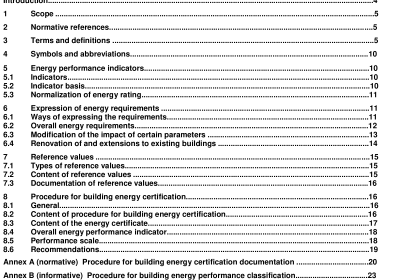BS EN 15217:2007 – Energy performance of buildings — Methods for expressing energy performance and for energy certification of buildings

5.3 Normalization of energy rating The overall indicator EP is the rating defined in prEN 1 5603 divided by the conditioned area A C . The type of dimensions used to calculate A C , internal dimensions, external dimensions or overall internal dimensions, shall be specified.
NOTE 1 The type of dimensions used has a high impact on the indicator obtained after normalization. For a house of 1 0 m × 1 0 m, the indicator obtained using internal dimensions could be 20 % larger than the one obtained with external dimensions.
NOTE 2 Usually the choice is the same as for the calculation of the transmission heat transfer (see prEN ISO 1 3789:2005); in addition, there is a direct correlation with input parameters that are related to the conditioned area (e.g. conventional hot water demand, minimum ventilation, lighting).
NOTE 3 An estimate of A C can be obtained from the conditioned volume and mean floor height.
6 Expression of energy requirements
6.1 Ways of expressing the requirements Two main types of requirements are defined:
a) overall energy performance requirement in accordance with 6.2;
b) specific requirements based on:
1 ) energy use for specific building services (e.g. heating, domestic hot water, cooling, lighting, ventilation);
2) energy need for heating, domestic hot water and cooling;
3) characteristics of the building itself or of its technical building systems considered as a whole (e.g. heat transfer coefficient of the building envelope, heating, domestic hot water or cooling system efficiency); 4) characteristics of the building envelope or technical building systems components (e.g. thermal transmittance of walls, efficiency of boilers, insulation of heating and hot water pipes, lighting power density (W/m ), specific fan power). 2 m Information on possible specific requirements is given in Annex D. An overall indicator may be combined with specific requirements. NOTE Reasons for doing that include:
1 ) to avoid too large tradeoffs between the performance of the building envelope and the performance of the technical systems;
2) to avoid technical health or discomfort risks;
3) to prevent components with low performance to be put on the market.
See Bibliography [1 ] for more background information on the advantages and disadvantages of additional requirements. The indicators used may be different for: a new building; renovation of an existing building; an extension to an existing building; different types of buildings.
BS EN 15217:2007 – Energy performance of buildings — Methods for expressing energy performance and for energy certification of buildings